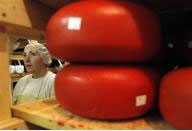
New England farms blossom in cheese renaissance
Wed Jul 23, 2008 9:25pm EDT

By Scott Malone
WEST PAWLET, Vt (Reuters) - Standing in a 144-year-old Vermont dairy farm making goat's milk Romano cheese in a 150-gallon (682-liter) stainless-steel mixer, Peter Dixon is at the heart of a revolution in American cheesemaking.
The 50-year-old dairy farmer is monitoring the stirring of the milk, which gets heated and mixed with a starter to separate the curd from the whey. Eventually molded into 20-pound (9 kg) wheels, the piquant product will command $22 a pound (0.5 kg) in high-end food shops and farmer's markets.
"I like to bring out the real character of the milk, rather than add a lot of cultures," explained Dixon, who will scrub the cheese periodically with salt water to help its flavor along as it ages three to four months in a cave-like room.
The Consider Bardwell farm is one of a growing number of small-scale farms in Vermont and across the country that are meeting demand for high-end farmstead cheese, a business model some find far more profitable than selling commodity milk.
Dixon knows all too well the need for new financial models after the collapse of his family's dairy farm under crushing debt. He works for Consider Bardwell's owners, a couple who split their time between New York careers and the growing cheese business.
The 300-acre (121-hectare) goat farm is one of 40 artisanal cheesemaking operations in Vermont, up from five a decade ago, and reflects a national trend of expanding U.S. production of handmade, specialty cheeses from California to Maine that seek to rival European-produced varieties.
Membership in the American Cheese Society has more than tripled from 426 in 2001 to 1,418 currently, and includes retailers, importers and even food writers.
A variety of factors are behind the surge of interest in farmstead cheese, ranging from a more discerning American palate to concerns about the safety of mass-produced foods.
A surging European currency has also helped by making high-end American cheeses—which can sell for $25 a pound, six times that of supermarket varieties—more competitive with those imports.
KEEPING FARMS 'IN THE LANDSCAPE'
For some, like Dixon, the appeal is simple: The interest in cheese helps small-scale farmers like him stay in business.
"In addition to what this farm produces, we're buying milk from four other farms, which helps sustain them," Dixon said at the farm, which lies outside a town of 1,436 people along Vermont's picturesque rural border with New York. "That's part of my goal here, to keep the farms in the landscape."
Vermont has seen 333 dairy farms fail over the past five years, with 1,100 remaining according to state figures, down from 11,019 in 1950. The main competitive challenge is massive Western dairy farms that milk hundreds of animals.
Farmstead cheese operations like Bardwell represent a sliver of the 9.7 billion pounds (4.4 billion kg) of cheese the United States produces and the $387 million worth of cheese it exports each year. There are no official statistics measuring U.S. production of specialty cheeses but evidence from farmers and industry officials suggests steady growth.
"As the quality of the cheese improves, the consumer says, 'Wow this is really fantastic, I love this,'" said Cathy Strange, global cheese buyer for Whole Foods Market Inc, the largest publicly held U.S. natural food chain. Artisanal cheese sales have grown steadily, she said.
'MORE CONTROL OVER YOUR DESTINY'
For farmers, cheese making offers a clear economic advantage. Fluid milk sells for about $18 per 100 pounds (45.36 kilograms), but when made into cheese can bring in about five times as much revenue.
"You just have so much more control over your destiny" selling cheese, said David Smith, 62, who started making cheese 23 years ago to improve profits at his dairy farm.
Smith's farmstead Gouda, cheddar and havarti are made on the Winchendon, Massachusetts, farm using milk from its 200 cows. It retails for about $8 to $13 a pound—a price Smith said meets less resistance today than it did when he started Country Cheese, his cheese business.
"With cheese you have a lot more flexibility," Smith said. "With fluid milk you have to sell it or smell it, but with cheese the older it gets, it has more value."
U.S. cheesemakers have also been helped by the euro's rise—up 17 percent against the dollar over the past year.
"American cheese once seemed quite expensive," said Matt Rubiner, owner of a cheese shop in Great Barrington, Vermont, whose stock of American cheese has grown from nothing to about a quarter of its selection just in the past few years.
"Those days are gone, at least for the time being," Rubiner said. "American cheeses ... often seem something of a bargain compared to some European cheeses."